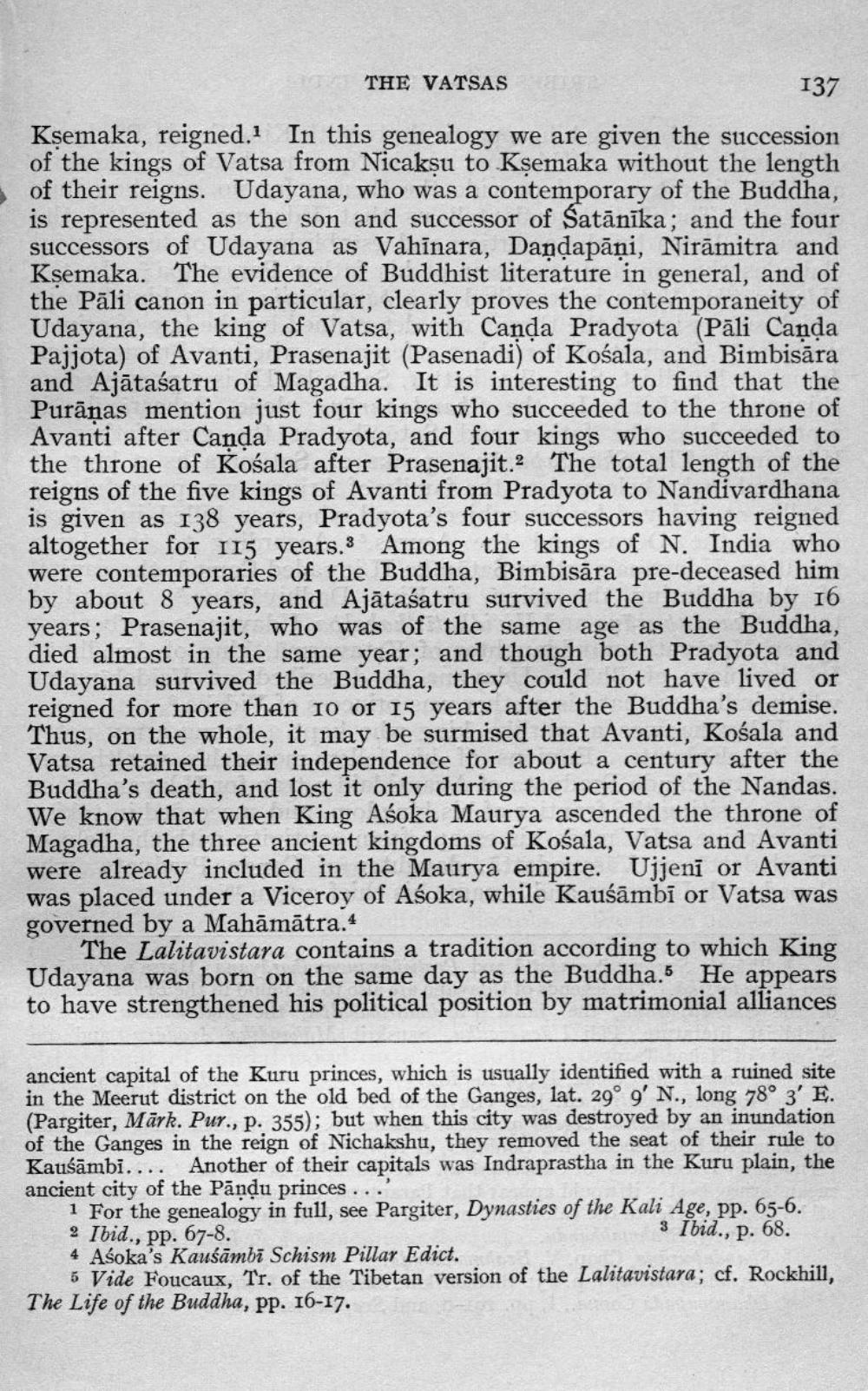________________
THE VATSAS
137 Ksemaka, reigned. In this genealogy we are given the succession of the kings of Vatsa from Nicaksu to Kșemaka without the length of their reigns. Udayana, who was a contemporary of the Buddha, is represented as the son and successor of Satānīka; and the four successors of Udayana as Vahīnara, Dandapāņi, Nirāmitra and Ksemaka. The evidence of Buddhist literature in general, and of the Pāli canon in particular, clearly proves the contemporaneity of Udayana, the king of Vatsa, with Caņda Pradyota (Pāli Caņda Pajjota) of Avanti, Prasenajit (Pasenadi) of Kośala, and Bimbisāra and Ajātaśatru of Magadha. It is interesting to find that the Purāņas mention just four kings who succeeded to the throne of Avanti after Canda Pradvota, and four kings who succeeded to the throne of Kosala after Prasenajit.2 The total length of the reigns of the five kings of Avanti from Pradyota to Nandivardhana is given as 138 years, Pradyota's four successors having reigned altogether for 115 years.3 Among the kings of N. India who were contemporaries of the Buddha, Bimbisāra pre-deceased him by about 8 years, and Ajātaśatru survived the Buddha by 16 years; Prasenajit, who was of the same age as the Buddha, died almost in the same year; and though both Pradyota and Udayana survived the Buddha, they could not have lived or reigned for more than 10 or 15 years after the Buddha's demise. Thus, on the whole, it may be surmised that Avanti, Kośala and Vatsa retained their independence for about a century after the Buddha's death, and lost it only during the period of the Nandas. We know that when King Aśoka Maurya ascended the throne of Magadha, the three ancient kingdoms of Kośala, Vatsa and Avanti were already included in the Maurya empire. Ujjenī or Avanti was placed under a Viceroy of Asoka, while Kaušāmbi or Vatsa was governed by a Mahāmātra.4
The Lalitavistara contains a tradition according to which King Udayana was born on the same day as the Buddha. He appears to have strengthened his political position by matrimonial alliances
ancient capital of the Kuru princes, which is usually identified with a ruined site in the Meerut district on the old bed of the Ganges, lat. 29° 9' N., long 78° 3' E. (Pargiter, Mārk. Pur., p. 355); but when this city was destroyed by an inundation of the Ganges in the reign of Nichakshu, they removed the seat of their rule to Kaušāmbi.... Another of their capitals was Indraprastha in the Kuru plain, the ancient city of the Pandu princes ...
1 For the genealogy in full, see Pargiter, Dynasties of the Kali Age, pp. 65-6. 2 Ibid., pp. 67-8.
3 Ibid., p. 68. 4 Asoka's Kaušāmbi Schism Pillar Edict.
5 Vide Foucaux, Tr. of the Tibetan version of the Lalitavistara; cf. Rockhill, The Life of the Buddha, PP. 16-17.




